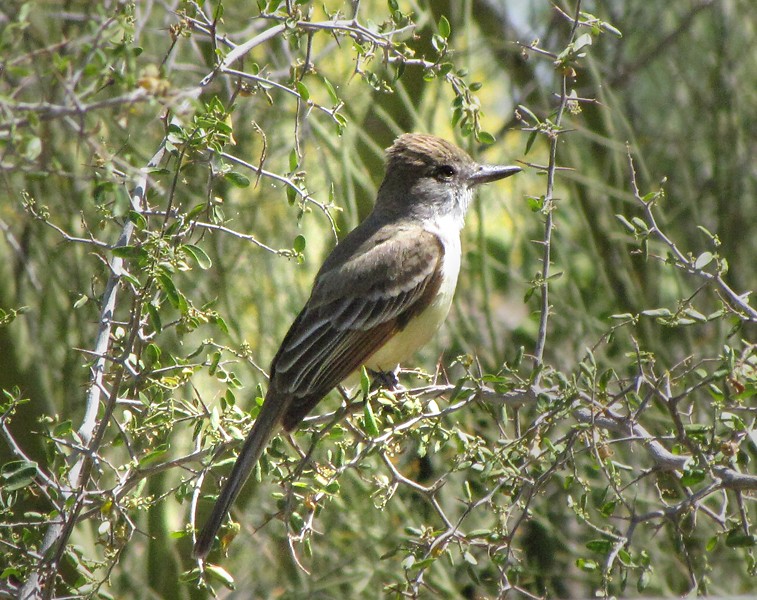Ash-throated Flycatcher
A species of New World Crested Flycatchers Scientific name : Myiarchus cinerascens Genus : New World Crested Flycatchers
Ash-throated Flycatcher, A species of New World Crested Flycatchers
Botanical name: Myiarchus cinerascens
Genus: New World Crested Flycatchers
Content
Description People often ask General Info
Description
The ash-throated flycatcher is a medium-sized tyrant flycatcher, measuring 7.5 to 8.6 in (19 to 22 cm) in length with a wingspan of 11.8 to 12.6 in (30 to 32 cm) and a mass of 0.7 to 1.3 oz (20 to 37 g). Overall, it is slim and long-tailed, with a slightly peaked crest on its relatively large head. 
Size
19-20 cm (7.5-7.75 in)
Colors
Brown
Black
Yellow
Red
Gray
White
Life Expectancy
11 years
Nest Placement
Cavity
Clutch Size
2 - 7 eggs
Incubation Period
1 - 2 broods
Number of Broods
14 - 16 days
Nestling Period
13 - 17 days
Feeding Habits
Ash-throated Flycatcher predominantly consume insects like wasps, bees, and various bugs, including their larvae. They also eat spiders, moths, and caterpillars, and occasionally supplement with small fruits. Ash-throated Flycatcher typically forage near the ground in open areas, catching prey in flight or while perching.
Habitat
Ash-throated Flycatcher thrives in semi-arid habitats like dry scrublands, open woodlands, and deserts. Found from sea level to 9,000 feet elevations, these birds frequent environments with oak, juniper, and pinyon pine. They depend on areas with available nesting cavities, often in standing dead trees. Their range extends seasonally into Mexico and Honduras, encompassing suburban areas and parks.
Nest Behavior
The female ash-throated Flycatcher is the presumed nest builder and may reuse the same cavity in following years. After construction, she lays eggs and along with the male, provides parental care which includes incubation and feeding of the young.
Nest Characteristics
Ash-throated Flycatcher's nest is typically found in pre-existing cavities such as those made by woodpeckers or in natural tree hollows. They readily adopt artificial cavities, including nest boxes and man-made structures, at varying heights up to 70 feet. The nest, taking 1-7 days to complete, is cup-shaped, made of twigs, grass, and bark, and lined with soft materials like hair or feathers.
Dite type
Insectivorous
People often ask
General Info
Feeding Habits
Bird food type
Bird Feeder Type

Platform
Sounds
Call
Recording location: Mexico
Song
Recording location: Mexico
Behavior
Ash-throated Flycatcher engage in active foraging, typically at lower arboreal levels and shrubbery, employing a 'sally' hunting strategy to capture prey. They exhibit distinctive head-bobbing and forward-leaning postures, particularly when disturbed. To cope with high temperatures, ash-throated Flycatcher utilize shaded perches and ventilate by holding wings away from their bodies. Remarkably, ash-throated Flycatcher are hydrated exclusively through their diet. As tenacious defenders of nesting cavities, they often evict other cavity-nesters, though they may face competition from certain species.
Species Status
Because of its extensive range, very large population, and generally increasing numbers, the ash-throated flycatcher has been listed as a species of least concern by the International Union for the Conservation of Nature. It is one of the species protected by the Migratory Bird Treaty Act. In the United States, the creation of bluebird trails, a network of nest boxes put out for the continent's three bluebird species, may benefit ash-throated flycatchers as they will also use the boxes. 
Scientific Classification
Phylum
Chordates Class
Birds Order
Perching birds Family
Tyrant flycatchers Species
Ash-throated Flycatcher 